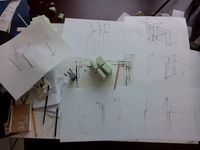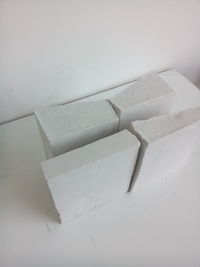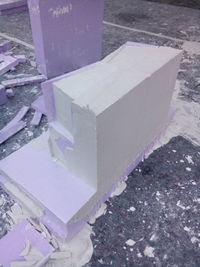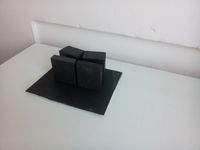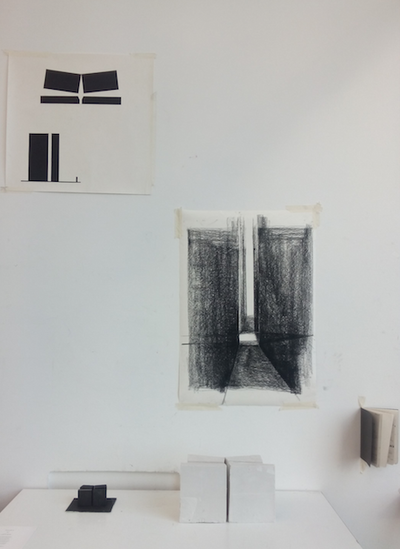Bauhaus SummerSchool: Difference between revisions
No edit summary |
No edit summary |
||
| (4 intermediate revisions by the same user not shown) | |||
| Line 47: | Line 47: | ||
'' "By weaving shapes, relations, proportions, and light, architecture can elevate new spatial experiences and phenomena, which is the theoretical foundation this course is built upon." '' | '' "By weaving shapes, relations, proportions, and light, architecture can elevate new spatial experiences and phenomena, which is the theoretical foundation this course is built upon." '' | ||
The course was a great opportunity to understand how spatial qualities can influence people's perception. Departure from a selection of various text passages from canonical German novels, each person had to choose one, interpret it, and carve out its inscribed spatial narratives and subtexts and transform all this into models. | |||
The texts therefore served as vehicles, which allow us to translate textual atmospheres and phenomena into architectural space. The ability for abstraction became key in the overall process. | The texts therefore served as vehicles, which allow us to translate textual atmospheres and phenomena into architectural space. The ability for abstraction became key in the overall process. | ||
The structure of course was divided in technical input on building molds, as well as theoretical lectures in which we were also investigating on phenomenological approaches in architecture with examples and case studies. | The structure of course was divided in technical input on building molds, as well as theoretical lectures in which we were also investigating on phenomenological approaches in architecture with examples and case studies. | ||
[[File:2015-08-11_12.55.10.jpg|200px|thumb|left|drawings]] | |||
[[File:IMG_20150814_125550.jpg|200px|thumb|left|caster mold]] | [[File:IMG_20150814_125550.jpg|200px|thumb|left|caster mold]] | ||
[[File:IMG_20150814_125602.jpg|200px|thumb|left| | [[File:2015-08-13_20.47.31.jpg|200px|thumb|left|before_foam mold]] | ||
[[File:IMG_20150814_125602.jpg|200px|thumb|left|after_foam mold]] | |||
Models and Drawings | |||
The process of turning the idea into a concrete physical shape, started by means of sketching freely on paper, and then moving towards drawing precise perspectives, and cross sections, to define in detail the proportions of the shapes. | |||
By intensively using large scale caster models and over-sized charcoal drawings, to meaningfully evaluate the models and carve out the relevance of shapes, relations, proportions and light. On the basis of handcrafted plaster models and charcoal drawings, was an interesting practice for dealing with high contrasts and its effects. | |||
Working with physical models was another interesting experience, being a third dimensional approach, it helps understand more accurately space qualities, and has proved to be one of the most fundamental methods to produce, assess and refine space – especially in contrast to our increasingly digitalised world. This was the final stage of testing field for experimenting with space and to evaluate it. | |||
[[File:Captura_de_ecrã_2015-09-8,_às_10.58.43.png| | [[File:Captura_de_ecrã_2015-09-8,_às_10.58.43.png|400px]] | ||
Latest revision as of 12:21, 1 November 2015
»SPATIAL POETRY« A PHENOMENOLOGICAL APPROACH
Angel-fair, Walhalla's charms displaying,
Fairer than all mortal youths was he;
Mild his look, as May-day sunbeams straying
Gently o'er the blue and glassy sea.
And his kisses!--what ecstatic feeling!
Like two flames that lovingly entwine,
Like the harp's soft tones together stealing
Into one sweet harmony divine,--
Soul and soul embraced, commingled, blended,
Lips and cheeks with trembling passion burned,
Heaven and earth, in pristine chaos ended,
Round the blissful lovers madly turn'd.
He is gone--and, ah! with bitter anguish
Vainly now I breathe my mournful sighs;
He is gone--in hopeless grief I languish
Earthly joys I ne'er again can prize!
Friedrich Schiller
Spatial Narratives – From Text to Space
"By weaving shapes, relations, proportions, and light, architecture can elevate new spatial experiences and phenomena, which is the theoretical foundation this course is built upon."
The course was a great opportunity to understand how spatial qualities can influence people's perception. Departure from a selection of various text passages from canonical German novels, each person had to choose one, interpret it, and carve out its inscribed spatial narratives and subtexts and transform all this into models. The texts therefore served as vehicles, which allow us to translate textual atmospheres and phenomena into architectural space. The ability for abstraction became key in the overall process.
The structure of course was divided in technical input on building molds, as well as theoretical lectures in which we were also investigating on phenomenological approaches in architecture with examples and case studies.
Models and Drawings
The process of turning the idea into a concrete physical shape, started by means of sketching freely on paper, and then moving towards drawing precise perspectives, and cross sections, to define in detail the proportions of the shapes.
By intensively using large scale caster models and over-sized charcoal drawings, to meaningfully evaluate the models and carve out the relevance of shapes, relations, proportions and light. On the basis of handcrafted plaster models and charcoal drawings, was an interesting practice for dealing with high contrasts and its effects.
Working with physical models was another interesting experience, being a third dimensional approach, it helps understand more accurately space qualities, and has proved to be one of the most fundamental methods to produce, assess and refine space – especially in contrast to our increasingly digitalised world. This was the final stage of testing field for experimenting with space and to evaluate it.

